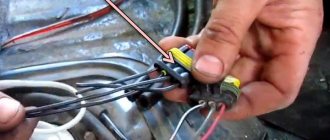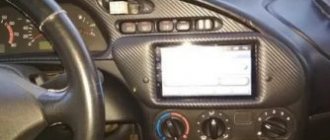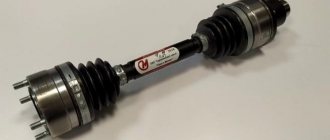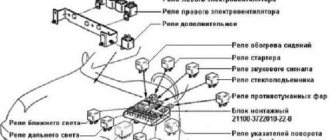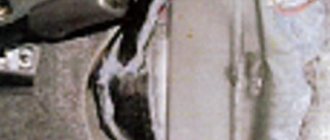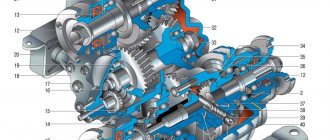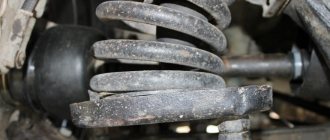From time to time, car owners have to drain gasoline from the tank. Sometimes you need a little fuel for a camper stove or to refuel another car. In other cases, it is necessary to drain all the gasoline to repair the fuel system or remove water or low-quality fuel from the tank. On older cars this operation could be done relatively easily. Now we have to face two problems:
- The long winding channel leading to the tank does not allow the hose to be pushed into it.
- A mesh installed at the filler neck prevents gasoline from draining.
Therefore, it is better to know several methods and apply them depending on the design of the gas tank and the fuel supply system. Below we will tell you how to drain gasoline from cars: VAZ 2109, 2110, 2114, 2115, Grants, Largus, Toyota, Niva, Priora, Patriot, Ford, Chevrolet.
Method 1. How to drain gasoline using a hose
The classic method that our grandfathers used. To drain the fuel you need to prepare two things:
- A hose (tube), the length of which depends on the design of the tank.
- Clean container for gasoline.
In the simplest case, the fuel pumping operation goes like this:
- Lower the hose (tube) into the tank so that it is immersed in gasoline.
- Cover the free end with your lips and draw in a strong breath.
- Direct the hose into the prepared container.
All that remains is to wait for all the fuel to flow out.
To drain only part of the fuel, it is enough to lift the hose above the neck so that gasoline stops flowing out.
Gasoline and octane boosters are harmful to health. Therefore, it is necessary to avoid their entry of fuel and its vapors into the body.
To prevent gasoline from getting onto the mucous membranes or into the stomach, special hoses are used to pump fuel. They are equipped with a bulb that must be squeezed before immersing the tube in the fuel and then released. If the design is not equipped with a check valve, vacuum in the line is created in a simple way:
- squeeze the pear;
- lower the hose into the gas tank;
- plug the hose outlet with your finger;
- release the rubber bulb;
- remove your finger.
The bulb can be replaced with an improvised piston . To do this, you will need a rope that runs freely inside the tube. It is better that it is made of soft natural material and not nylon. At the end of the rope you need to tie several knots, and then:
- Thread the rope and pull lightly so that the piston from the knots enters the hose.
- Insert the hose into the gas tank.
- Smoothly pull out the rope.
- Lower the hose (tube) into the prepared fuel container.
- remove your finger.
The moving “piston” creates a vacuum that causes gasoline to flow from the tank.
However, all tricks with a hose are only relevant for old cars. The gas tank of modern cars (Grants, Largus, Toyota, Niva, Priora, Patriot, Ford, Chevrolet) is located far from the filler neck. In this case, you need to use other methods.
Chevrolet Niva tank design
The gas tank is a welded structure made of sheet steel. This provides it with sufficient strength and safety. Steel is well welded and soldered. This makes it possible to eliminate minor damage to the walls. However, when condensation forms, the internal surface becomes corroded, creating the risk of rust entering the fuel system. Initially, the Niva Chevrolet was equipped with gas tanks manufactured by General Motors. Their factory part number is GM 212301101011000.
Advice: on the spare parts market, tanks made at AvtoVAZ are more often found. Their quality is not inferior to the original ones, and the price starts from 8,000 rubles.
Method 2. Drain gasoline through the fuel line and the plug at the bottom of the gas tank
If the fuel pump is located not in the tank itself, but near the engine, you can try to drain the fuel through the fuel line. Procedure:
- Unscrew the clamp and disconnect the hose going from the tank to the fuel pump.
- Place the hose into the fuel container.
Fuel will leak from the gas tank. The main thing is that the end of the fuel line, as well as the fuel container, is located below the gasoline level.
Some cars have gas tanks with drain plugs. If you are the owner of just such a car model, you need to use an overpass or inspection hole to drain the fuel. This is done simply:
- Place a container under the drain plug in the gas tank.
- Unscrew the plug.
- Drain the fuel (all or part of it).
- Tighten the plug.
However, plugs at the bottom of the tank are not very common. In this case, the fuel pump will help drain the gasoline. The method is suitable for old modern cars.
Replacement frequency, what antifreeze to fill
According to the maintenance regulations, replacing antifreeze in a Chevrolet Cruze car should be done once every 3 years or 45 thousand kilometers. But these recommendations were written quite a long time ago, because modern coolants are designed for a much longer period of use.
When using General Motors branded product Dex-Cool Longlife as a coolant, the replacement period will be 5 years. It is ideal for use in GM vehicles and is available as a concentrate.
The original antifreeze has complete analogs: Havoline XLC in the form of a concentrate and Coolstream Premium in the form of a finished product. The latter is more suitable for hardware replacement at a car service, by replacing the old fluid.
As an alternative, you can select fluids that meet GM Chevrolet approval. For example, a good option would be the domestically produced FELIX Carbox, which also has an extended service life.
How much antifreeze is in the cooling system, volume table
| Model | Engine capacity | How many liters of antifreeze are in the system | Original liquid / analogues |
| Chevrolet Cruze | gasoline 1.4 | 5.6 | Genuine General Motors Dex-Cool Longlife |
| gasoline 1.6 | 6.3 | Havoline XLC | |
| gasoline 1.8 | 6.3 | Coolstream Premium | |
| diesel 2.0 | 9.5 | FELIX Carbox |
Method 3. How to drain gasoline using a fuel pump
The only way to drain fuel from the tanks of most fuel-injected cars is to use the fuel pump. Open the hood and disconnect the fuel hose from the ramp pipe and direct it into a prepared fuel container.
If you then turn on the ignition, the electric pump will start for a few seconds and pump 200-300 grams of gasoline. To pump out more fuel, you need to use one of two options:
- Periodically turn the ignition on/off so that the pump pumps gasoline in small portions.
- Remove the electric pump turn-on relay and close the pump power contacts. In this case, the pump will pump gasoline until the ignition is turned off.
Gasoline is being drained, what to do?
It is difficult to imagine that in the 21st century it is possible to steal fuel from a tank. But residents of disadvantaged areas face this all the time. Experts will tell you what to do to prevent gasoline from being drained, how to protect your car from gasoline drainage.
- What to do to prevent gasoline from being drained?
- Methods of protection.
- Punish the thief.
- Installing a lid with a lock.
- Do not leave fuel behind.
- Tank neck protection.
- Signaling extension.
- Parking against a wall or pole.
- Hide the hatch.
- The thief's deception.
- Video.
Recommendations
Comments 30
I installed a reed switch on the gas tank flap, since these caps can be broken off without any problems, and this will at least scare off the drainers. The installation report is in my logbook
This article does not beat in Exist. Please clarify.
Right now I’m looking for a lid with a lock and so that it is on a cord. Well, it’s like a factory one and I haven’t found anything like it anywhere. can you tell me?
I also had doubts about the cord, I was wondering where to attach it, or whether it would be stolen at a gas station... Don’t think about it! You'll get used to it, like me, without a lace! It hangs perfectly on the hatch door with its slots))
I put the lid on the classic and now I’m looking for it in my pocket, then at the gas station)
My lid has slots for hanging it.
I'll look for some. Thank you
To be honest, I didn’t find one with a lock and a cord... I didn’t find it here either www.chevy-niva.ru/
Right now I’m looking for a lid with a lock and so that it is on a cord. Well, it’s like a factory one and I haven’t found anything like it anywhere. can you tell me?
Have you tried parking your car in a guarded parking lot?
No! Otherwise, the whole point of owning a car is lost)) I even go to the store 2 houses away by car...
And after this, people say that they love their cars, take care of them, while leaving them in an unguarded area at night. And then they start yelling: “Help! The car was stolen, the wheels were removed, the gasoline was drained, they shit on the roof, acid was poured on the hood,” etc. Hmmm... You correctly said that the point of owning a car is in owning it. What will you own if your car is burned or stolen? A piece of scrap metal or a title form with a bunch of keys? God grant that all of the above does not affect you. But, having worked for a single year at UGRO in the area of crimes related to AMTS, I will never leave my car at night in an unguarded area (and have never left any of my cars), because... I don't want to be a crying idiot.
Read more: Galvanizing the body of a Chevrolet Aveo
Thanks for the answer! It’s worth thinking about additional means of car protection... There have already been tips to point a web camera at the car from an apartment window...
Mesh in the pipe. I recently encountered the same thing. Business nonsense! These covers break very easily. There is an entry in the logbook.
Surely each of us has encountered a situation when we need to get rid of excess fuel in the tank. Don't roll it out, but drain it. There can be a lot of reasons for this - condensation, water ingress, diesel fuel was poured in instead of gasoline, and this has happened. Let’s figure out how to drain gasoline from a Niva Chevrolet without removing the tank right now.
What to do to prevent gasoline from being drained
Despite the fact that cars have alarms, fuel thieves easily manage to drain gasoline or diesel fuel from the fuel tank of cars, trucks, and motorcycles. Some people don’t really worry about it, well, they drained it and drained it, I’ll fill it again. But now gasoline and diesel fuel are quite expensive for the majority of the country’s population, so it is necessary to come up with protective methods against draining. On classic rear-wheel drive models VAZ 2101, 2102, 2103, 2104, 2105, 2106, 2107, draining the fuel is quite simple, because the neck in the tank is without bends; the thief inserted a hose, sucked it in and drained it. Next come cars from which it is more difficult to drain gasoline, for example, Lada Priora, Granta, Vesta, X-Ray, UAZ Patriot, Niva, Ford Focus, Renault Duster, Sandero, Chevrolet models, etc.
How to protect your car from draining gasoline - a review of effective methods
The Criminal Code provides for a fine or administrative punishment for fuel theft. Finding the perpetrator and proving guilt can be difficult. To avoid trouble, it is important to secure your transport in advance.
Fill with something else instead of gasoline
In case of regular theft, car owners are advised to “punish the thief.” To do this, fill in 2-3 liters of diesel fuel instead of gasoline. They are similar in color and smell. The compression ratio of a gasoline engine is less than that of an internal combustion engine, so diesel fuel will not ignite. The car twitches and suddenly stalls. To get away, thieves will need to flush the entire fuel system. It is important for the owner not to accidentally start the engine. It is worth considering liability for damage to someone else's property. If the thief proves that you intentionally caused harm, you will have to pay him compensation.
Install the lid with a lock
At the car market you can pick up a cover with a locking mechanism (costs approximately 500-800 rubles). When closing with a key, the retractable bolts block the rotation of the lid in the neck. But such a solution will not provide 100% protection. To open the lock, criminals use a pry bar to pry it open. As a result, the car owner will be left without fuel, and even with damaged paintwork.
Do not leave fuel in the tank
In the morning you will have to refuel from the canister, and in the evening you will have to drain the rest. The inconveniences include unnecessary work and the need to carry a spare container. To drain the fuel yourself, place an empty canister under the bottom of the gas tank and unscrew the cap.
If you don’t want to get your knees dirty, you can go another way:
- With the engine off, disconnect the fuel pump hose (at the connection with the fuel filter);
- lower the free end into the canister;
- turn on the ignition (without starting the engine) and the pump will begin pumping;
- reconnect the hose.
It is recommended to leave 1-2 liters of fuel in the tank so as not to air the system. Some injection models have a special drain fitting.
Put protection on the neck
On domestic cars, attackers insert a hose into the tank to “suck” gasoline. This can be avoided by using an anti-drip glass. It is made of stainless steel and lasts throughout the entire period of operation of the car. Comes in different diameters. Secured with two counter-threaded screws. To remove it you will need a special tool. It has many holes along the edges that serve as a coarse filter. This solution does not interfere with refueling. The downside is the need to drill the body.
Install an alarm
A standard car alarm does not have sensors for opening the gas tank flap. Its capabilities will need to be expanded. To do this, install the limit switch in place of the rubber stop of the lid and connect it to the trunk opening sensor.
The operation of feedback alarms is based on 3 principles:
- keychain sounds;
- headlights flash;
- The engine compartment siren starts.
Domestic cars
Let's look at 5 ways to drain fuel on popular brands of the domestic automobile industry.
VAZ 2110, 2112, 2114 (injector), Lada Granta
The methods listed below are also suitable for those cars where there is a protective mesh in the fuel neck.
Method 1.
Drain fuel only when the engine is cold.
Would need:
- connector for connecting to the fuel pump (sold separately) and a wire to it up to 3 meters long.
- a hose up to 3 meters long and with a diameter suitable for the fuel pump fitting.
- clamp;
- two crocodiles for connecting to the battery;
- metal canister;
- rags.
Algorithm of actions:
- Fold down the two rear seats and unscrew the fuel pump access flap.
- Disconnect the wire connector.
- Relieve pressure in the system. To do this, remove the engine protective cover. Find the special fitting (it is shown in the photo below) and release the pressure by pressing the button. To prevent fuel from spilling, place a small container with a volume of up to 0.5 liters.
- Find the fuel supply hose on the pump; as a rule, it is single. Double return hose. Follow the arrow on the pump cover.
- By pressing the bracket, remove the fuel supply hose.
- Connect the prepared hose to the fitting and secure it with a clamp. Place its other end into the prepared container.
- Connect a pre-prepared connector to the pump by first extending its wire to 3 meters.
- Remember where the positive and negative wires are located and use alligator clips to connect them to the battery. Plus to plus, minus to minus.
- Gasoline will begin to flow into the container.
- Reverse the steps to return everything to its original position. Please note, do not rush to remove the hose from the canister. First, disconnect it from the fitting and drain the remaining fuel.
Method 2.
Similar to the first one, only we disconnect the hose in front near the engine:
- To the right of the engine near the exhaust manifold, find the fuel supply hose. It releases easily thanks to the spring latches. The disconnect location is shown in the diagram below.
- Connect to it a pre-prepared hose at least 3 meters long. Place the other end into a metal container.
- Turn on the ignition. The pump will start working and pump out fuel. It is not recommended to start the car as the pump may fail.
About 100 - 150 ml of gasoline will drain at a time. Next, turn off the ignition and turn it on again.
Method 3.
Suitable for injection vehicles VAZ 2110, 2112, 2114, Lada Granta. We also take a hose and container.
- Remove the fuel pressure valve cap and use a regular cap to unscrew the nipple.
- Insert the hose. We lower its second end into the canister.
- Turn on the ignition. While the pump is pumping, fuel will drain.
- We repeat the procedure until we add the required amount of fuel.
Methods 2 and 3 are not suitable for situations where you need to completely drain the gasoline. Frequently turning the ignition on and off will quickly drain the battery, and if you start the car, there is a high probability that the pump will idle and burn out.
On the Lada Granta we also find a fitting for measuring pressure, it is located in the same place as on the VAZ 2110. All operations are performed in the same way.
Alternatively, you can use the following method.
Method 4.
The hose is connected using the methods already described above or directly to the fuel rail.
We find the fuel pump relay and close the contacts on it. On 2112, 2111, 2110 the relay is located below to the right of the driver.
Turn on the ignition. The pump will run continuously. But here it is important to know how much fuel is in the tank in order to control the draining process and prevent the pump from burning out. The entry of air with fuel is a signal that the ignition needs to be turned off.
In this simple way you can drain gasoline from the injectors of domestic cars.
VAZ classic (carburetor), old foreign cars
Option 1.
As a rule, in such cars there is no mesh in the neck, therefore, in order to drain fuel from the tank, it is enough to have a special hose with a bulb for pumping fuel.
We lower one end of the hose into the gas tank, the other into the canister and begin pumping. Usually at 5-10 pumping, gasoline begins to flow.
Please note that on the bulb itself there is an arrow indicating the direction of fuel movement.
Option 2.
Using a regular hose and your lungs. It is important here not to inhale gasoline vapors or swallow flammable liquid.
To prevent this, use a transparent pipe that is not too thick (4-6 mm) and not very long (from 2 to 3 meters no more). We cut one side at an angle of 70 degrees, this will allow fuel to drain better.
Lower the hose into the tank so that it touches the bottom. Then, if you haven't cut it, lift it a couple of centimeters. This is done so as not to block the hose hole with the bottom of the tank.
The ideal option is for the hose to lie on the bottom of the tank in a semi-circle, this will ensure maximum pumping of fuel. To do this, attach a small weight near the end of the pipe. Where the fuel line has several bends, the option with a load does not work.
Start sucking, with your mouth below the expected level of gasoline in the tank.
The higher the fuel rises through the tube, the harder it will be to create a vacuum. If the hose is transparent, then the process will be visually visible.
As a result, gasoline will begin to drain, the main thing is to redirect it from the mouth into the canister in time.
What mistake was made in the video, write in the comments.
Option 3, 4.
For those who are afraid of swallowing fuel, you can assemble the following structures.
Take a 1.5/2.0 liter container and make two holes in its lid. Insert two pipes and fill the place where they go with epoxy resin. Screw on the cap.
The end of the hose through which air will be sucked in should be higher in the bottle than the one that goes into the tank. This can be seen in the diagram.
We begin to suck in air, without inhaling gasoline vapors and eliminating the possibility of tasting the flammable liquid.
Or, in order to drain fuel from the tank, we use a homemade pump. To do this, take the same pipe as in the method described above (maybe a little thicker) and a rope 10% longer.
Pass the rope through the hose and tie a knot at one end so that it passes through the hole with force.
Soak the knot in water and tighten it into the hose. The swollen node will completely block the passage. Place the knotted end of the hose into the tank and begin pulling the rope through. The vacuum created will pull fuel with it, which will eventually begin to drain.
Option 4.
Using a vacuum cleaner. For this you will need:
- the vacuum cleaner itself;
- container with a tight lid;
- two rubber tubes.
We assemble the structure:
- We make two holes in the lid of the container into which we tightly insert two hoses. Fill the area with epoxy resin to prevent air from passing through.
- We connect the first pipe through a seal (or in another way) to the vacuum cleaner, and lower the second pipe into the tank.
Turn on the vacuum cleaner for suction. Thanks to the vacuum created, gasoline will begin to flow into the container.
Option 5.
Tritely simple. Find out whether the design provides for the presence of a drain plug in the gas tank of your car.
If yes, then drive the car onto a pit (overpass) or lift it with a lift. Unscrew the plug and drain the fuel.
By the way, if there is no such plug, you can install it yourself.
The disadvantage of this method is obvious; it eliminates the possibility of quickly draining fuel on the road, for example, if you need to help someone.
UAZ Patriot
On a UAZ Patriot, draining gasoline from the tank using the usual “folk” method will not work. You can use a fuel pressure valve for this. We find it and unscrew the spool with the cap. We collect the spilled fuel into a prepared container.
We connect a pipe with a diameter of 8 mm to the valve.
We find the fuse box, remove the cover and find the fuel pump relay in it. Remove and install the jumper to complete the circuit. It is advisable to insert a 5-10A fuse into the jumper itself.
Even without the key inserted into the ignition, gasoline will begin to drain. In 3 minutes you can drain up to 10 fuel.
Niva Chevrolet
The Niva Chevrolet has a fuel tank installed in the body and therefore does not have a drain hole. But the advantage is that there is no protective mesh in the filler neck pipeline and it is relatively flat. Therefore, most of the methods described above are suitable for draining gasoline in this case.
It is important to consider that the tank itself is located far from the filler neck, so in order to capture the fuel, the pipe must be about 3 meters long and with a diameter of 4 to 8 mm.
Also, many car owners, to protect against fuel drainage, install a meat grinder mesh with large holes in the filler pipe of the Niva Chevrolet.
If you have installed such a grid, then you will have to drain the fuel using a gas pump (this is discussed above).
Lada Priora, Kalina
The fuel tank of the Lada Kalina is made of plastic; gasoline is not drained from below. Also, the filler hole itself is located in the center of the tank, and not on the side.
Therefore, the pipe from the filler neck to this hole is long and has two bends.
The advantage is that there is no protective mesh in the filler pipe. Therefore, all is not lost.
Prepare a canister and a hose at least 2.5 - 3 meters long with a diameter of 1-1.5 cm. So that it fits freely into the neck.
Run the hose inside. At first it will go freely and even the first bend will not cause any special difficulties. Then it will rest against the second bend and here you need to start rotating it counterclockwise, as if you were cleaning a sewer.
Blow into the hose and make sure it goes down into the tank. Drain the gasoline using a blower or by creating a vacuum with your mouth (methods described above).
The problem is that the fuel tank on the Lada Kalina is too low, and therefore you will have to bend down to the ground for the fuel to start draining. Or drive the car into a pit or overpass.
You can also drain the fuel from the Lada Kalina (Cross) by connecting to the fuel system through the fuel pressure control valve, we wrote about this above. Or get to the fuel pump through the rear seats, see how to do this above.
Using the same methods, you can drain fuel on the Lada Priora.
How to drain gasoline from your car's tank?
When refueling with low-quality fuel or if you urgently need gasoline for some purpose, you can drain the gasoline from the car tank. But how to do this if the filler neck is above its level? Folk methods, special devices or little tricks can come to the rescue. Let's talk about this.
When do such cases occur? Not to say that it happens that often, but it happens. If, after filling with low-quality fuel, the car begins to stall or the engine runs unstably, then it is better to drain the gasoline.
It happens that it’s a long way to a gas station and you simply need gasoline, for example, to refuel another car, or to light a fire in winter, or to process something. It doesn’t matter why you need gasoline, the main thing is that you need it and need to drain it, so let’s look at different methods.
Methods - how to drain gasoline from a tank
Carburetor engine
If you need a small amount of gasoline, such as half a liter or a liter, and you have a carburetor engine, you can do the following. Start the engine and let it run for a while. Open the hood and locate the carburetor. Usually it is located approximately in the middle of the engine compartment and is attached to the intake manifold.
Find the fuel supply hose, it should go visually from under the bottom of the car and secured along the body, then fit onto the fuel supply fitting of the carburetor. We will need it. Do not confuse with other hoses, because one of the other hoses is the engine crankcase gas intake. Watch where they go so you don't make a mistake.
Usually the hose is put on and taken off with a simple movement without effort. But it may turn out that it is reinforced with a clamp. In this case, loosen the clamp with a screwdriver. Place the container and enjoy the process:
Having prepared a container for gasoline (for example, a plastic bottle), without turning off the engine, disconnect this hose from the carburetor. Gasoline should flow out of it. Place the container and enjoy the process. Periodically reconnect the hose back to the carburetor to fill it with a supply of gasoline and prevent the engine from stalling. Repeat these procedures until the container has the required amount of gasoline.
The gasoline that is in the carburetor chambers will not allow the engine to stall, so the engine will run for some time at idle speed. The gas pump, if it is located in the tank, will also work, so gasoline will flow out of the hose in a small stream, which is what we need.
Be careful not to let leaking gasoline get on hot parts of the engine and exhaust manifold, otherwise it may result in a fire. It’s most convenient to do this with two people - one sits in the driver’s seat with the door open, the second drains the gasoline and, if something happens, gives the command to turn off or start the engine.
After this procedure, put the hose back in place and tighten the clamp (if there was one). When starting the engine, you will most likely have to crank the starter longer so that gasoline has time to fill all the carburetor channels and enter the ignition system. Also, do not be surprised if the engine runs unstably at first and even stalls - this will pass. It just needs to work until the level of gasoline in the system is restored.
This method is good for domestic carburetor cars . On most foreign cars, it may be unsuccessful if, for example, the electronics detect depressurization and block the fuel supply, or if the required pressure in the fuel system for gasoline to run out is not created. Personally, I used this method to drain gasoline from a Honda Integra in order to make a fire in the winter.
Through the tank neck using a hose
A well-known method. All you need is a hose, the desired length is about a meter. One end of the hose is lowered into the tank so that it is immersed in gasoline. You can determine how deep it needs to be lowered into the tank by following the traces of gasoline. Lowering it deeper each time, we take it out and see if the end is wet. When we see that the end of the hose is wet in gasoline, we lower it to the same depth + 20-30 cm.
Stages of replacing coolant in a Chevrolet Cruze
This model does not have a drain hole on the engine block, so for a complete replacement it is recommended to flush the cooling system. This will allow you to completely get rid of the old liquid so that it does not deteriorate the properties of the new one.
The instructions for replacing the coolant are applicable to cars produced under different automobile brands produced by the GM concern. They are complete analogues, but are produced for sale in different markets:
- Chevrolet Cruze (Chevrolet Cruze J300, Restyling);
- Daewoo Lacetti Premiere;
- Holden Cruze.
In our region, petrol versions with a volume of 1.8 liters, as well as 1.6 109 hp, are popular. There are other variations, for example 1.4 petrol and 2.0 diesel, but they are much less common.
Coolant drain
The replacement can be made on any flat surface; an overpass is not necessary; the required places are easily accessible from the engine compartment. It is also not necessary to remove the engine protection. After all, you can put a hose on the drain hole and take it out into an empty container located in a convenient place.
Before starting draining the Chevrolet Cruze, the manufacturer recommends letting the engine cool to at least 70°C, and only then proceeding with the procedure. All actions in the instructions are described from a standing position facing the engine compartment:
- We unscrew the cap of the expansion tank to allow air flow into the cooling system (Fig. 1).
Fig. 1 Expansion tank cap On the left side of the radiator at the bottom we find a drain hole with a valve (Fig. 2). We put a hose with a diameter of 12 mm on the drain to drain the old antifreeze into the container. After which you can open the valve. Now the old antifreeze will not flood the protection, but will gently flow out through the hose.
Fig. 2 Drain hole with valve To drain completely, it is recommended to remove the pipe that goes to heating the throttle valve (Fig. 3).
Fig. 3 Pipe on the throttle valve We also unscrew the air vent plug located on the left in the upper part of the radiator (Fig. 4). It is better to use a screwdriver with a thick minus tip for this.
Fig.4 Air outlet plug
- If sediment or deposits on the walls are observed in the expansion tank after draining, you can remove it for washing. To do this, you need to remove the latches that secure it to the body, disconnect the 2 hoses and pull them out towards you. For easier removal, you can remove the battery.
In this way, the maximum amount of liquid is drained, but due to the absence of a drain plug on the engine, some of the antifreeze remains in it. In this case, it can only be removed by washing with distilled water.

